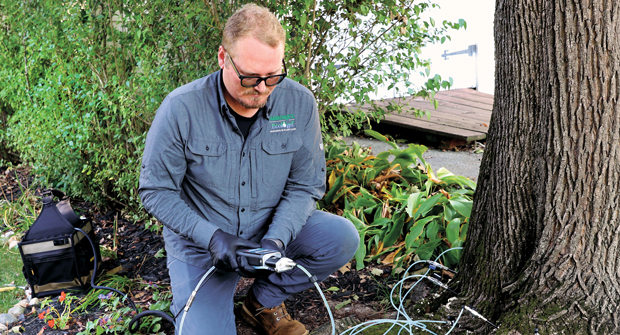Invasive insects have become an increasingly pressing problem across North America in the 21st century. Global travel allows species to hitchhike from one continent to the next faster and more frequently. Once settled into their new homes, these insects find new food sources, wreaking havoc on trees without the evolutionary protections needed to coexist with their new neighbors.
One of the most well-known, widespread examples is emerald ash borer (EAB), which first appeared in Michigan in the early 2000s. This metallic green beetle lays its eggs in bark crevices; once hatched, the larvae then feed on vascular tissue. This disrupts the tree’s ability to transport water and nutrients, causing death from the inside out if left untreated.
Since its accidental introduction from Asia in 2002, EAB infestations have killed more than 100 million ash trees across North America. Ashes are an especially popular choice for urban planting given their canopy size and ability to grow in almost any type of soil. With global temperatures rising, the large-scale loss of this tree species removes much-needed shade from cities and suburbs, areas where heat is reflected off buildings and sidewalks.
EAB is not a unique example. Invasive pests such as spotted lanternfly and Asian longhorned beetles are taking a devastating toll on different tree species across the country. Even native pests, such as the pine bark beetle, are expanding their range due to warming temperatures.
The “solution” to these infestations is commonly presented as binary — spray pesticides or lose thousands of trees. One issue with pesticide sprays is the lack of confinement to the target pest. Waterways, soils and non-host plants can be affected, in addition to key pollinators and other animal species that are critical to a balanced ecosystem. Topical sprays — those applied to the surface of the target plant or tree — are of limited utility, require large amounts of product and cannot guarantee precision. If you want to save trees, but you don’t want to spray pesticides, what can you do to treat for invasive pests?
Tree injection has become a common method for arborists over the past two decades. The practice first became common in the 1970s. It involves the administration of treatment directly into the tree’s vascular system, which then disperses the product through its trunk, branches and leaves. These targeted, controlled injections have helped eradicate infestations and protect countless trees across the country.
Precise injections reduce the overall amount of solution needed compared to a topical spray. Given that the injectable formulations are less diluted, it eliminates the need for a large backpack or tank-mixing truck onsite. For those who believe tree injections take too much time, field tests have shown that applications on large trees can be completed in minutes. Additionally, multiple trees can be worked on at once for increased efficiency on large jobs.
And for those who believe that tree injection is prohibitively expensive, the practice is cost effective in the long run; each injection only requires a few milliliters of product and often provides two or three years of active control.
As for the impact on surrounding environments, product injected into trees remains confined to the wood and leaves. This reduces impacts on the surrounding soil, water and air, leaving off-target species unharmed. Pollinating insects interacting with treated trees face minimal risk, and they can be further protected by ensuring product is injected after the tree has finished flowering and producing pollen.
Across the green industry, tree injection is becoming a more common offering for plant health care professionals of all stripes. Tree injection can be “added on” to a number of business models without significant barriers to entry beyond initial equipment and formulation purchases, plus some training. In turn, a well-equipped and trained tree injection team opens the door for repeat business.


